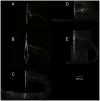Propagation of epileptiform events across the corpus callosum in a cingulate cortical slice preparation
- PMID: 22363643
- PMCID: PMC3283628
- DOI: 10.1371/journal.pone.0031415
Propagation of epileptiform events across the corpus callosum in a cingulate cortical slice preparation
Abstract
We report on a novel mouse in vitro brain slice preparation that contains intact callosal axons connecting anterior cingulate cortices (ACC). Callosal connections are demonstrated by the ability to regularly record epileptiform events between hemispheres (bilateral events). That the correlation of these events depends on the callosum is demonstrated by the bisection of the callosum in vitro. Epileptiform events are evoked with four different methods: (1) bath application of bicuculline (a GABA-A antagonist); (2) bicuculline+MK801 (an NMDA receptor antagonist), (3) a zero magnesium extracellular solution (0Mg); (4) focal application of bicuculline to a single cortical hemisphere. Significant increases in the number of epileptiform events, as well as increases in the ratio of bilateral events to unilateral events, are observed during bath applications of bicuculline, but not during applications of bicuculline+MK-801. Long ictal-like events (defined as events >20 seconds) are only observed in 0Mg. Whole cell patch clamp recordings of single neurons reveal strong feedforward inhibition during focal epileptiform events in the contralateral hemisphere. Within the ACC, we find differences between the rostral areas of ACC vs. caudal ACC in terms of connectivity between hemispheres, with the caudal regions demonstrating shorter interhemispheric latencies. The morphologies of many patch clamped neurons show callosally-spanning axons, again demonstrating intact callosal circuits in this in vitro preparation.
Conflict of interest statement
Figures








Similar articles
-
Spatiotemporal organization and thalamic modulation of seizures in the mouse medial thalamic-anterior cingulate slice.Epilepsia. 2011 Dec;52(12):2344-55. doi: 10.1111/j.1528-1167.2011.03312.x. Epub 2011 Nov 16. Epilepsia. 2011. PMID: 22092196
-
Propagation dynamics of epileptiform activity acutely induced by bicuculline in the hippocampal-parahippocampal region of the isolated Guinea pig brain.Epilepsia. 2005 Dec;46(12):1914-25. doi: 10.1111/j.1528-1167.2005.00342.x. Epilepsia. 2005. PMID: 16393157
-
Effects of Small Temperature Differences Detected in Callosal Circuits of the Anterior Cingulate Cortex.Neuroscience. 2020 Jan 21;428:154-164. doi: 10.1016/j.neuroscience.2019.12.041. Epub 2020 Jan 7. Neuroscience. 2020. PMID: 31918013
-
How does the corpus callosum mediate interhemispheric transfer? A review.Behav Brain Res. 2011 Sep 30;223(1):211-21. doi: 10.1016/j.bbr.2011.04.018. Epub 2011 Apr 21. Behav Brain Res. 2011. PMID: 21530590 Review.
-
Functional and pharmacological properties of GABA-mediated inhibition in the human neocortex.Can J Physiol Pharmacol. 1997 May;75(5):526-34. Can J Physiol Pharmacol. 1997. PMID: 9250388 Review.
Cited by
-
Anterior Cingulate epilepsy: mechanisms and modulation.Front Integr Neurosci. 2014 Jan 3;7:104. doi: 10.3389/fnint.2013.00104. Front Integr Neurosci. 2014. PMID: 24427123 Free PMC article. Review.
-
Epilepsies and Mirror Movements: An Underrecognized Association?J Clin Med. 2025 Apr 16;14(8):2738. doi: 10.3390/jcm14082738. J Clin Med. 2025. PMID: 40283567 Free PMC article. Review.
-
Functional Impairments in Learning and Signal Propagation Following Prenatal Kynurenine Treatment in Mice.Eur J Neurosci. 2025 Jul;62(1):e70185. doi: 10.1111/ejn.70185. Eur J Neurosci. 2025. PMID: 40640113 Free PMC article.
-
Properties of the epileptiform activity in the cingulate cortex of a mouse model of LIS1 dysfunction.Brain Struct Funct. 2022 Jun;227(5):1599-1614. doi: 10.1007/s00429-022-02458-1. Epub 2022 Feb 1. Brain Struct Funct. 2022. PMID: 35103859 Free PMC article.
-
Thalamo-cortical network underlying deep brain stimulation of centromedian thalamic nuclei in intractable epilepsy: a multimodal imaging analysis.Neuropsychiatr Dis Treat. 2017 Oct 17;13:2607-2619. doi: 10.2147/NDT.S148617. eCollection 2017. Neuropsychiatr Dis Treat. 2017. PMID: 29089767 Free PMC article.
References
-
- Spencer SS. Corpus callosum section and other disconnection procedures for medically intractable epilepsy. Epilepsia. 1988;29(Suppl 2):S85–S99. - PubMed
-
- Spencer SS, Spencer DD, Sass K, Westerveld M, Katz A, et al. Anterior, total, and two-stage corpus callosum section: differential and incremental seizure responses. Epilepsia. 1993;34:561–567. - PubMed
-
- sadi-Pooya AA, Sharan A, Nei M, Sperling MR. Corpus callosotomy. Epilepsy Behav. 2008;13:271–278. - PubMed
-
- Marcus EM, Watson CW. Symmetrical epileptogenic foci in monkey cerebral cortex. Mechanisms of interaction and regional variations in capacity for synchronous discharges. Arch Neurol. 1968;19:99–116. - PubMed
-
- Erickson TC. Spread of the epileptic discharge - An experimental study of the after-discharge induced by electrical stimulation of the cerebral cortex. Archives of Neurology and Psychiatry. 1940;43:429–452.

